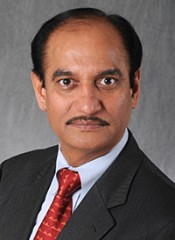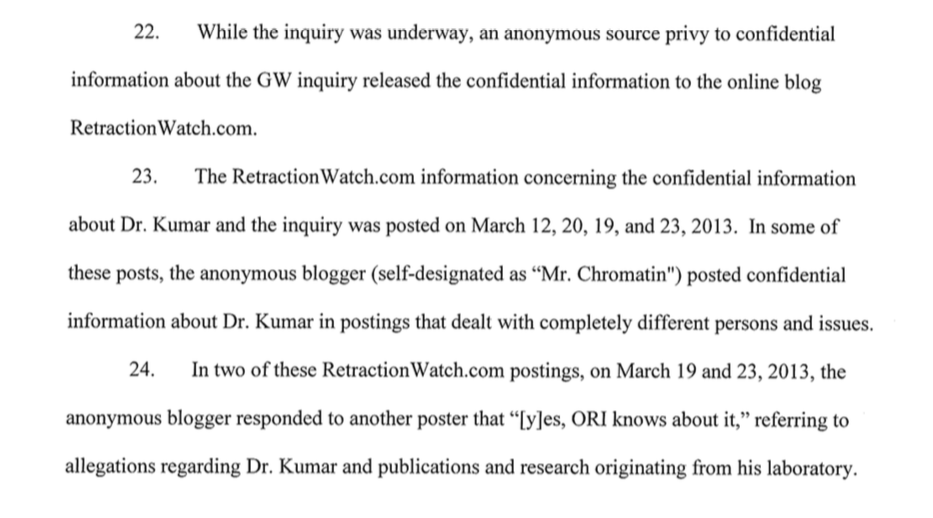
Maybe the polar vortex is to blame (chilling effect, and all), but it must be lawsuit season!
First it was Mario Saad, . Now Rakesh Kumar is getting in on the action. According to George Washington University student paper the GW Hatchet, Kumar was put on administrative leave from his position as chair of the department of biochemistry and molecular medicine in May 2014, though he was still allowed to run his lab until July 25. In response, he’s suing the university for breach of contract and emotional distress. You can read the whole thing here.
Kumar is asking for $8 million, claiming that GW failed to go through the firing procedure outlined in his tenure contract and owes him because he can’t get a new job.
The exact nature of the accusations against Kumar, who has had five papers corrected and two retracted for problematic images, is unclear. According to the suit, a copy of which RW has obtained:
None of the allegations set forth in the misconduct proceedings asserted that Dr. Kumar conducted the underlying research or personally ever fabricated or falsified research data or prepared the figures in question for any of the manuscripts at issue in the proceedings. Rather, all but one allegation centered on Dr. Kumar’s supervision of the junior scientists in his laboratory and the existence of an allegedly stressful laboratory environment. The one remaining allegation had woefully inadequate evidentiary support.
In addition to the accusations of poor lab management, the researcher also claims he found it especially galling to be escorted from a July 25, 2014, meeting by campus police:
Dr. Kumar’s removal by GW Security was very public and humiliating and has irreparably damaged Dr. Kumar’s reputation.
We haven’t been left out of the matter, either. The lawsuit mentions comments posted in March 2013 on unrelated articles — although, like many people unversed with the terminology of the internet, whoever wrote the document mixed up bloggers and commenters (click for a full-sized version):
Here’s the comment in question, which a “Mr. chromatin” posted a few times on the site:
JBC should retract the following two papers. May be it is waiting for a correction, just like the recent correction in PNAS (http://www.pnas.org/content/110/10/4147.extract.html). ORI knows it all.
Sankaran et al., February 17, 2012, Vol.287, No.8,
Marzook et al., February 17, 2012 Vol 287, No.8,
Fig no. 7C from Marzook matches with Fig. no. 8b and 8d of Sankaran.
Fig no. 7A from Marzook matches with Fig. no. 8c of Sankaran.
Hat tip the American Bazaar.

Here on PubPeer is a possible background for GW University decision: http://goo.gl/Wss7Cn
Of note: those are papers in high-level journals like Nature, Nat Cell Biol, PNAS etc
Apparently the whole thing started by Paul Brookes on his now shut-down sciencefraud.org
Correct Leonid, although of course I was acting on behalf of a tipster who remains anonymous. In fall 2012 we documented 20 separate papers with problems. They are listed below, by PubMed ID # (C = corrected, R = retracted):
22203674 R
22184113 C
22700976
20519513
11146623
11208715 C
12167865
12198493
12151336
12611881 C
12912973
15173068
15226262
15193260 C
15983119 C
15831477 C
16617102 C
17505058 C then R
17671180
17671172
There’s also 14530270 which was a Clare Francis hit that came in after the fact.
It should also be noted that Kumar threatened legal action against me in the fall of 2012. He seems to have changed lawyers for this particular attempt – the stakes are certainly higher. The issue was resolved when some wording on the pages was edited.
The following statement from the lawsuit is telling… “The committee (draft report) concluded that Dr. Kumar committed misconduct in ten of the allegations”. 10 out of 21 doesn’t quite equal a “preponderance of the evidence”, so there might be something to be made on that basis, but nevertheless 10 is still a number bigger than zero, and that’s probably why GW did what they did.
I have no idea who “Mr. Chromatin” is, but I like his style.
Paul, I was actually wondering why he didn’t set his lawyers on you. In fact, how is it with libel laws in regard to science publications and the data therein? Is it a grey area, where people like Kumar, Sarkar, Anversa etc have a chance to win in court?
Well, at least somewhere the university will not side with and cover facts concerning some ongoing investigation and/or claims on published material. Oh if every place were like such!… So many young, competent, scientists giving up for lack of open positions and opportunity!.. Maybe things will improve in the future? Let us see.
“because he can’t get a new job.”
That applies to millions of people
This law-suit also shows the great dangers for whistle-blowers and the risks associated even with anonymity. At the end of the day, everything comes back to bite where it hurts most. An increase in law-suits may also have a chilling effect on PPPR. As more and more scientists find errors and want to report them, when they see these cases, they start to think twice about sharing their opinions. Things are just getting messier and messier.
In the end, these people just draw more attention to themselves (the formerly Streisand, now Fernandez, effect). However, if someone leaked confidential information, they are in a bit of trouble. Not so much with Kumar, unless GW guaranteed him confidentiality, but with ORI. Anyone who has dealt with these things at the institutional level knows better than to reveal an investigation. You can insinuate as much, but you cannot come out and say that someone is being investigated by them.
This case is more like the suit against Harvard. http://retractionwatch.com/2015/01/28/bad-image-prompts-correction-harvard-brigham-stem-cell-paper-anversa/
” Rather, all but one allegation centered on Dr. Kumar’s supervision of the junior scientists in his laboratory and the existence of an allegedly stressful laboratory environment.”
Were those inadequatelty supervised,”junior scientists”, NIH funded trainees ?
They’re fortunate that they were not the ones held accountable for the fraud, which has happened in the past.
It’s long past the time when NIH Training grant applications should establish criteria based on the quality of the training to be provided . For example, what was the ratio of “trainees” to mentor ? What does the University require of mentors?
A recently reported survey of trainees in Mass. found complaints best summarized by the complaint that they were not trainees, they were “cheap labor”.
Don.
Marvellous! It is always a pleasure to study anew one of the most stunning figures in the biological sciences, as created by Badlamudi and Kumar and published in Nature Cell Biology (impact factor 42)
http://imagizer.imageshack.us/a/img855/8826/80hb.jpg
The entire 2002 article is just awesome with many more hidden treasures to be enjoyed by following the discussion at PubPeer
https://pubpeer.com/publications/12198493
In 2002, Kumar was not yet at GW. That paper was produced at the place which once upon a time liked to rate itself as the top cancer hospital in the world
http://www.cancerletter.com/articles/20130719
One wonders what was in the GW job description and whether past performance is of any value to the defence?
Of course everybody now knows not to publish in NPG journals and that PNAS is so much better.
http://retractionwatch.com/2013/12/11/cell-nature-science-boycott-what-was-randy-schekmans-tenure-at-pnas-like/
Indeed, while the above 2002 NCB article is still in its pristine state, a 2006 PNAS paper of MD Anderson vintage is believed to have received some corrections. For whatever reason, PubMed still points to the original figures in all their splendour
Fig. 1
http://www.ncbi.nlm.nih.gov/pmc/articles/PMC1458939/figure/F1/
Key features of Fig. 1 marked
http://i.imgur.com/B8b6j1h.png
Fig. 2
http://www.ncbi.nlm.nih.gov/pmc/articles/PMC1458939/figure/F2/
Key features of Fig. 2 marked
http://i.imgur.com/2AHA385.png
Enjoy!
John Heartfield himself would be proud of those collages, Scrutineer.
Absolutely! Check out these
http://en.wikipedia.org/wiki/John_Heartfield#mediaviewer/File:Bundesarchiv_Bild_102-05929,_Berlin,_KPD-Plakat_zu_den_Reichstagswahlen.jpg
I sought to make a joke by deliberately confusing finger duplication with figure duplication but, on second thoughts, it isn’t going to work. John Heartfield was a very brave person.
Anyway, here are a couple of interesting figures from a 2004 JBC paper marked up in the usual way.
http://i.imgur.com/l1QXOPD.jpg
I hope those are ironic typefaces. I am trying to console myself with the thought that “at least they aren’t Papyrus”.
Regarding the fonts, it is obvious that the Marker-Upper should use a font (and colours) that can’t be confused with the original figure. Inevitably, this requirement tends to result in rather lurid schemes, predominantly using italicised and/or hand-writing scripts. With, of course, as many different colours as needed to avoid confusion. In this particular case, I used two fonts: “Stencil” and “Brush Script” and, if I remember correctly, six different colours.
The “Papyrus” font, lacking gravitas, is unlikely to feature in the original figure. Even so, it is not ideal for Mark-Up as it is a regular font and hence might not be obviously different enough, especially if the marked-up image is saved at low resolution.
Finally, it should be acknowledged that “Marker Felt” is, for obvious reasons, a perennial favourite in the figure sleuthing community.
GW appears to have filed a motion to dismiss the Kumar lawsuit with supporting documents but the documents are paywalled (see below). Can anyone provide access to these documents?
https://www.pacermonitor.com/public/case/6685473/KUMAR,_PHD_v_GEORGE_WASHINGTON_UNIVERSITY
More filings in this case. Could anyone make them available?
https://www.pacermonitor.com/public/case/6685473/KUMAR,_PHD_v_GEORGE_WASHINGTON_UNIVERSITY